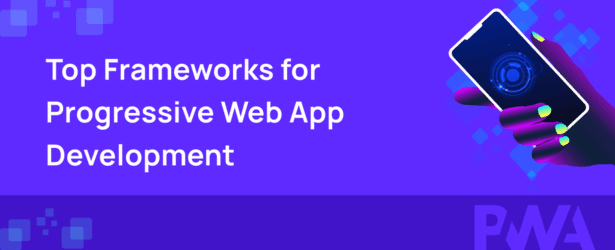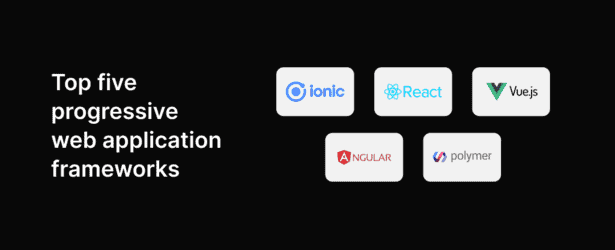Top Frameworks for Progressive Web App Development
23 Feb 24 


Have you ever thought, about how could you deal with a day without technology? We have come so far, in such a way that technology has changed our life drastically.
Businesses that fail to adapt to shifting trends have faced the consequences. BlackBerry’s failure to adapt to touchscreen trends led to its decline, losing ground to Apple and Samsung.
As reported by Statista, the current global smartphone user base totals 6.7 billion, with estimates anticipating a surpassing of 7 billion within the next three years. This rapid growth underscores the pivotal role smartphones now play as essential channels for cultivating loyalty and engagement.
What are Progressive Web Apps?
In the past, people thought native apps were the best for mobile. But they couldn’t do everything the users wanted. So, Progressive Web Apps (PWAs) came along. PWAs are great because they work on different devices and platforms. They’re like a mix of native apps and have some cool new features. PWAs are like regular websites but they act like apps, even sending notifications. Most big web browsers like Chrome and Opera fully support PWAs, and Firefox is almost there too. Even Samsung Internet now supports PWAs, and Apple is starting to use them too, adding important stuff like service workers.
Top five progressive web application frameworks

It’s undeniable that Progressive Web Apps (PWA) are rapidly gaining popularity in the world of smartphones. If you’re considering leveraging this technology to market your business, the first crucial step is to determine the framework you’ll use to build your app. With so many options available, selecting the right one can make all the difference in the success of your PWA. Therefore, it’s important to carefully evaluate each framework and choose the one that best aligns with your business goals and needs.
There are a variety of PWA frameworks out there, but not all of them are created equal. To aid your decision-making process, we’ve curated a selection of the finest choices currently accessible.
Angular

Angular, developed by Google in 2009, is a widely used PWA framework. It uses JavaScript to build responsive and reliable apps.
The latest version, Angular 13, offers great features like TypeScript 4.4 support, user-friendly APIs, and enhancements to testing. Even developers with less experience can create high-quality PWAs using this framework.
Key benefits of Angular
- Easy to Learn: Angular simplifies app development with its straightforward structure and clear documentation.
- TypeScript Support: With support for TypeScript 4.4, developers can write cleaner and more organized code.
- Improved Testing: Angular 13 includes enhancements to testing, making it easier for developers to ensure their apps are bug-free.
- Ergonomic APIs: The framework provides user-friendly APIs that streamline the development process.
- Wide Adoption: Angular is widely adopted by companies and developers worldwide, ensuring a strong community and ample resources for support.
Disadvantages of Angular
- Angular can be tough for beginners because it’s more complicated to understand compared to simpler frameworks.
- Angular apps might take longer to load and use more memory, especially on older devices or slow internet.
React

React, backed by Facebook, is a widely used and powerful PWA framework. Developers love it because of its vast JavaScript library and flexibility. With React app development, you can easily connect HTML elements using JSX. Plus, there are plenty of packages available to help you expand and enhance your app or project.
Key benefits of React
- Component-Based: React uses a component-based architecture, making it easy to break down complex UIs into smaller, reusable pieces.
- Virtual DOM: React employs a virtual DOM, resulting in faster rendering and improved performance by minimizing unnecessary updates to the actual DOM.
- Large Ecosystem: React has a vast ecosystem with a multitude of libraries, tools, and community support, allowing for rapid development and scalability of projects.
- Declarative Syntax: React’s declarative syntax simplifies the process of writing UI components, making code more readable and easier to maintain.
- Support by Facebook: Being backed by Facebook ensures ongoing development, stability, and access to resources and updates for developers.
Disadvantages of React
- React’s learning curve can be difficult for beginners.
- React requires writing more code compared to simpler frameworks.
- React’s ecosystem evolves rapidly, making it challenging to keep up with updates.
Vue

If you’re new to programming, you might not know about Vue because it’s newer compared to React and Angular.
But don’t overlook it! Vue is gaining popularity fast thanks to its fast-growing library.
It’s known for two things: speedy rendering and easy coding. And just like React, you can use extra packages to expand your app with Vue.
Key benefits of vue
- Easy to Learn: Vue is beginner-friendly, making it simpler for new developers to understand and use.
- Fast Rendering: Vue offers speedy rendering, ensuring that your app loads quickly and responds smoothly to user interactions.
- Simplicity: Vue’s syntax is straightforward and easy to follow, allowing developers to write clean and concise code without unnecessary complexity.
- Flexibility: Vue provides flexibility in terms of integration with existing projects and the ability to scale up with additional packages as needed.
- Growing Community: Vue has a growing community of developers who contribute to its ecosystem, providing ample resources, tutorials, and support for users.
Disadvantages of vue
- Vue may have fewer resources and community support compared to more established frameworks like React and Angular.
- The ecosystem around Vue, including third-party libraries and tools, may not be as extensive as that of other frameworks.
- While Vue is beginner-friendly, mastering more advanced features and concepts may still require time and effort.
Ionic

Ionic, launched in 2013, is an open-source framework based on Angular and Apache Cordova. It’s been used to build over 5 million hybrid apps. With Ionic, developers can use its components to design apps for both iOS and Android. It works by running web pages inside a device’s browser using WebView, giving them a native app feel.
Advantages of Ionic
- Cross-Platform Compatibility: Ionic allows developers to create apps that work seamlessly on both iOS and Android devices, reducing development time and costs.
- Rich Component Library: Ionic provides a wide range of pre-designed UI components, making it easy to create visually appealing and interactive apps without starting from scratch.
- Web Technologies: Ionic leverages web technologies like HTML, CSS, and JavaScript, allowing developers to use their existing skills to build powerful mobile apps.
- Native Functionality: Ionic apps can access device features and APIs through plugins, enabling developers to incorporate native functionality into their applications.
- Community Support: With a large and active community, Ionic offers plenty of resources, tutorials, and support for developers, making it easier to troubleshoot issues and find solutions.
Disadvantages of ionic
- Ionic apps may not perform as well as native apps, especially for complex or graphics-intensive applications.
- Since Ionic apps run inside a WebView, they may not have access to all native device features and APIs, limiting their capabilities compared to fully native apps.
- While Ionic is based on web technologies, there may still be a learning curve for developers who are not familiar with Angular or web development concepts.
Polymer

Polymer, created by Google and open-source, offers a vast array of tools, web components, and templates, simplifying PWA development.
Its tools and components are compatible with various browsers, ensuring adaptability and accessibility for apps built with Polymer. Using pure HTML, CSS, or JavaScript, Polymer stands out as an independent framework.
Benefits of Polymer
- Full support for routing, data handling, and responsive layouts.
- An easy-to-understand API.
- Embedded development tools that reduce the need for additional debugging tools.
Disadvantages of Polymer
- Polymer’s single-page application architecture can hinder SEO optimization.
- Polymer apps may experience slower initial loading times compared to traditional web applications.
- Polymer lacks an official integrated development environment (IDE), which may require developers to rely on third-party tools for development and debugging.
Final thoughts
When it comes to building a progressive web app, choosing the right framework is crucial. Each of the five PWA frameworks has its unique advantages, but determining which one is right for your app depends on several factors, including your app’s needs and the expertise of your development team. That’s why working with a quality developer like Mindster can be such a great choice. Our team of experienced developers has extensive knowledge of all the major PWA frameworks, and we can help you choose the one that’s best suited for your project. With Mindster on your side, you can be confident that your PWA will be responsive, scalable, interactive, robust, and user-friendly. So why wait? Choose Mindster for your app development needs and start enjoying all the benefits that PWAs have to offer.
- Android Development3
- Artificial Intelligence27
- Classified App3
- Custom App Development2
- Digital Transformation11
- Doctor Appointment Booking App13
- Dropshipping1
- Ecommerce Apps38
- Education Apps2
- Fintech-Apps35
- Fitness App2
- Flutter3
- Flutter Apps19
- Food Delivery App5
- Grocery App Development1
- Grocery Apps3
- Health Care7
- IoT2
- Loyalty Programs9
- Matrimony Apps1
- Microsoft1
- Mobile App Maintenance2
- Mobile Apps120
- Product Engineering5
- Progressive Web Apps1
- Saas Application2
- Shopify7
- Software Development1
- Taxi Booking Apps7
- Truck Booking App5
- UI UX Design8
- Uncategorized4
- Web App Development1















Comments